- Learning time
- 60 minutes
- First play time
- 180 minutes
Le Havre
Designed by: Uwe Rosenberg
In the game of Le Havre, the French port of the same name is being built up over a number of rounds: players gather resources, upgrade them, spend them… and make money. At the end of the game the richest player will be the winner.
The board is laid out on the table and all the various resource chits placed on it in their denoted spots. A number of building cards – depending on player count – are used in each game; the rulebook clarifies which ones and how they’re set up. Players each have a wooden ship and a disc that’s referred to as a worker. The boats are placed next to the board to the left of the waterway: on your turn, you’ll move your boat to the next available space and do two things: first, the place your boat stops at triggers adding resources to one of the offer spaces on the board – money, fish, clay, wood, iron, grain and cattle all have their own offer space.
Then you have a choice: either take all resources from an offer, or place your worker on an unoccupied building, taking the action the building provides. At the start of the game there are only three buildings already ‘built’ – and therefore available – but as things progress players will be either building (paying resources) or buying (paying cash) buildings from three stacks of ‘unbuilt’ buildings: if you’ve collected enough clay, for example, you can build the Bakehouse. The Bakehouse is now your building, and you can use it for free. Anyone else must pay you (1 food) for the privilege.
This paying for building use isn’t Le Havre’s only catch. The other is that a worker placed in a building stays there until it’s moved on, blocking the building from use by others – this can be an inadvertent irritant, but it can also be a deliberate ploy!
Because everyone is constructing these buildings, Le Havre becomes more complex as it continues, with multiple buildings available and a plethora of tactical and strategic choices: every resource can be upgraded (clay becomes bricks, cattle become meat and so on; the Bakehouse mentioned above will turn your grain into bread) and upgraded resources in turn can either build more advanced buildings, be sold for more money, or feed more people.
Ah, yes, feeding. When the boats reach the end of the waterways, every player must feed their worker a certain amount of food: fish, bread, meat, or cash will do it. But while the opening couple of rounds just has your worker peckish, every subsequent round their appetite increases, giving you a small aspect of fire-fighting to navigate alongside your building-of-things. However, this can be negated to some degree by building ships: not only do ships allow you to sell your resources for cash, they also provide a food benefit at the end of every subsequent round: do not neglect ship-building! You’re in a port, after all.
So out of Le Havre’s simple heart of get stuff/spend stuff a more complex game emerges, where every seemingly micro-decision is important, because (for example) if you want to build that steel ship you not only need to get iron, you need to turn it into steel, and you need to spend wood/coke/coal as energy when you go to the Wharf to build it, which means the Wharf needs to be a. built! and b. not occupied by another player, getting in your way… being able to plan ahead, join the dots, connect the cogs or whatever analogy you prefer, does no harm at all!
The guru's verdict
-
Take That!
Take That!
By and large everyone is in theory, doing their own thing. But play does overlap in how the buildings are built, and how you must pay to use another player's building, and indirectly, in fact, in lots of ways - from the filling up of the offers to the building of the ships.
-
Fidget Factor!
Fidget Factor!
High on a first play. Thereafter moderate-to-high, depending on how many players you have. It's probably best with 2 or 3 - with more players than that not only does the game lengthen exponentially overall, the idea of planning anything goes out of the window.
-
Brain Burn!
Brain Burn!
As mentioned above, what opens as a relatively simple "Oh, I'll just pick some grain up then" fast-moving gathering of resources will escalate into a multitude of options. Not only do the players erect buildings, so does the town itself, triggered at the end of certain rounds.
-
Again Again!
Again Again!
Enormous variety here.

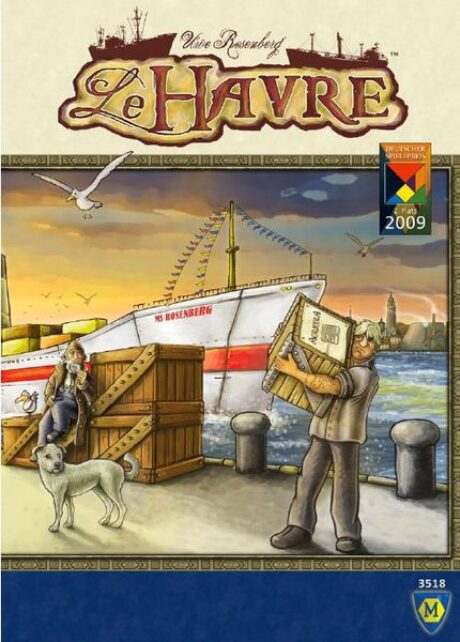
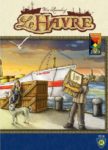
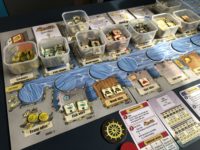
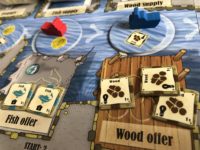
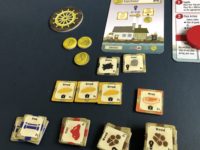
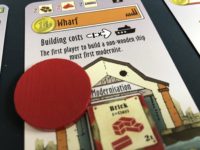
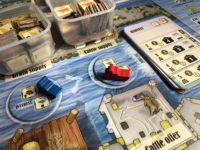


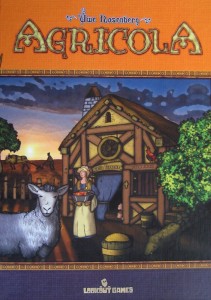
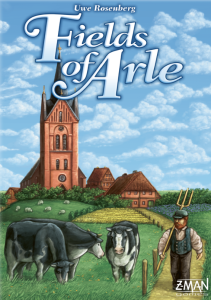

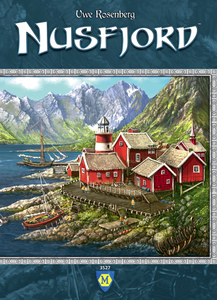

Sam says
At time of writing I've played Le Havre three times and it's kind of blown my mind. Whereas the designer's previous Agricola and subsequent Caverna do a very similar thing mechanically, the theme of what you are doing in those games (building a farm) comes through very clearly. With Le Havre, although each small element makes sense - turning grain into bread, then either eating it or selling it - as a whole it's nowhere near as intuitive as those two - it feels far more like an abstract puzzle, sort of borrowing notions from the physical world and incorporating them into 'story' that's so vague even the rulebook doesn't try bother clarifying beyond the box's description of 'managing a harbour'. But that said, this game is extraordinary in the depth it generates - there's not a huge amount of randomization in set-up, but the repercussions of every single players' decisions cascade through the rest of the game - and even a minor deviation from one play to the next can have huge import on the resulting play. Far less chaotic than it might appear, kind of genius in its construction, massive replayability, but not one for the faint-hearted.